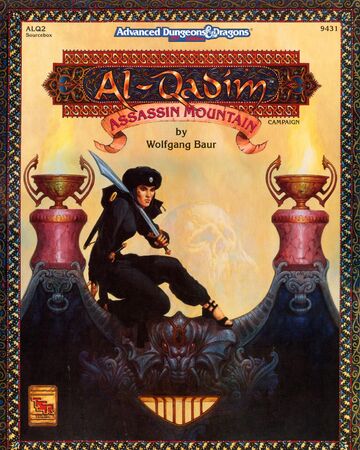In my A Game Per Year project, my goal has been to read one roleplaying game corebook for every year they’ve been published. However, I soon started to feel that it was hard to decipher how the games were really meant to be played. For this reason, I decided to start a parallel project, An Adventure Per Year, to read one roleplaying adventure for each year they’ve been published.

In the Book of the Marvels of the World, Marco Polo tells the story of the Order of Assassins, led by the Old Man of the Mountain and taking refuge in the castle of Alamut. The story has been influential in the world of pop culture, nowhere more so than in the Assassin’s Creed series of videogames. In roleplaying, the most famous example is probably the Assamite clan in Vampire: the Masquerade (or Children of Haqim in the 5th edition).
Al-Qadim is one of the settings published for Advanced Dungeons & Dragons in the setting explosion of the late Eighties and early Nineties, born in the same period as Dark Sun, Spelljammer and Birthright. One feature of that era were subsettings connected to the Forgotten Realms, inspired by real history and cultures. Thus, the core Western fantasy world of Forgotten Realms acquired the China and Japan -based Kara-Tur to the east and the Aztec, Maya and Inca -inspired Maztica to the west.
Based on 1001 Nights and similar Arabian stories, Al-Qadim is another of these subsettings, this time to the south, although it did have more of it’s own identity than any of the others.
Assassin Mountain is an adventure published for Al-Qadim, based on the story of the Order of Assassins. It details different assassin orders with a focus on one, called the Everlasting. There are rules for making assassin characters (it’s a Thief kit, for those who remember how this worked in AD&D 2nd Ed.), details of the fortress and factions at the titular Assassin Mountain and a three-part adventure involving player characters.
In the first adventure, the assassins try to extort money and goods from people at a remote desert inn. In the second, an assassination attempt during a parade launches a series of events whereby the characters are tasked with traveling to Assassin Mountain to dissuade the assassins from killing a local notable. In the third, the characters are at the Mountain, trying to solve the mystery of who wants to betray the leader of the assassins.
In the second adventure, there are two siblings intent on revenge against the assassins. They act as guides on the way to the Mountain. There’s a note about one of them possibly having a romantic entanglement with a player character. I was left wondering how this is assumed to be played out. I know how I’d run it, but that doesn’t answer the question of how it was intended in it’s original context of play culture.
The third adventure is my favorite since it’s a social scenario, all about talking to the various factions in the Mountain and trying to figure out what’s happening. Everyone’s amoral to one degree or another and all believe themselves to be righteous. It’s surprisingly ambiguous from a moral standpoint.